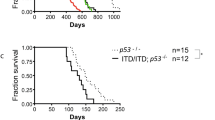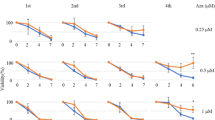Abstract
The presence of internal tandem duplications (ITD) mutations in the FMS-like tyrosine kinase 3 (FLT3) receptor influences the risk of relapse in acute myeloid leukaemia (AML). We have investigated DNA repair in FLT3-ITD and wild-type (WT) cells. Using the comet assay, we have demonstrated that the FLT3 inhibitor PKC412 significantly inhibits repair of DNA damage in the MV4-11-FLT3-ITD cell line and FLT3-ITD patient samples but not in the HL-60-FLT3-WT cell line or FLT3-WT patient samples. Following the discovery that transcript levels of the DNA repair gene RAD51 are significantly correlated with FLT3 transcript levels in FLT3-ITD patients, we further investigated the role of RAD51 in FLT3-ITD-AML. The reduction in DNA repair in PKC412-treated FLT3-ITD cells was shown to be associated with downregulation of RAD51 mRNA and protein expression and correlates with the maintenance of phosphorylated H2AX levels, implying that PKC412 inhibits the homologous recombination double-strand break repair pathway in FLT3-ITD cells. Using FLT3-short interfering RNA (siRNA), we also demonstrated that genetic silencing of FLT3 results in RAD51 downregulation in FLT3-ITD cells but not in FLT3-WT cells. This work suggests that the use of FLT3 inhibitors such as PKC412 may reverse the drug-resistant phenotype of FLT3-ITD-AML cells by inhibiting repair of chemotherapy-induced genotoxic damage and thereby reduce the risk of disease relapse.
This is a preview of subscription content, access via your institution
Access options
Subscribe to this journal
Receive 12 print issues and online access
$259.00 per year
only $21.58 per issue
Buy this article
- Purchase on Springer Link
- Instant access to full article PDF
Prices may be subject to local taxes which are calculated during checkout







Similar content being viewed by others
References
Grimwade D, Walker H, Oliver F, Wheatley K, Harrison C, Harrison G et al. The importance of diagnostic cytogenetics on outcome in AML: analysis of 1,612 patients entered into the MRC AML 10 trial. The Medical Research Council Adult and Children's Leukaemia Working Parties. Blood 1998; 92: 2322–2333.
Nakao M, Yokota S, Iwai T, Kaneko H, Horiike S, Kashima K et al. Internal tandem duplication of the FLT3 gene found in acute myeloid leukemia. Leukemia 1996; 10: 1911–1918.
Kottaridis PD, Gale RE, Frew ME, Harrison G, Langabeer SE, Belton AA et al. The presence of a FLT3 internal tandem duplication in patients with acute myeloid leukemia (AML) adds important prognostic information to cytogenetics risk group and response to the first cycle of chemotherapy: analysis of 854 patients from the United Kingdom Medical Research Council AML 10 and 12 trials. Blood 2001; 98: 1752–1759.
Schnittger S, Schoch C, Dugas M, Kern W, Staib P, Wuchter C et al. Analysis of FLT3 length mutations in 1003 patients with acute myeloid leukemia: correlation to cytogenetics, FAB subtype, and prognosis in the AMLCG study and usefulness as a marker for the detection of minimal residual disease. Blood 2002; 100: 59–66.
Hayakawa F, Towatari M, Kiyoi H, Tanimoto M, Kitamura T, Saito H et al. Tandem-duplicated FLT3 constitutively activates STAT5 and MAP kinase and introduces autonomous cell growth in IL-3-dependent cell lines. Oncogene 2000; 19: 624–631.
Mizuki M, Fenski R, Halfter H, Matsumura I, Schmidt R, Muller C et al. FLT3 mutations from patients with acute myeloid leukemia induce transformation of 32D cells mediated by the Ras and STAT5 pathways. Blood 2000; 96: 3907–3914.
Weisberg E, Boulton C, Kelly LM, Manley P, Fabbro D, Meyer T et al. Inhibition of mutant FLT3 receptors in leukemia cells by the small molecule tyrosine kinase inhibitor PKC412. Cancer Cell 2002; 1: 433–443.
Stone RM, DeAngelo DJ, Klimek V, Galinsky I, Estey E, Nimer SD et al. Patients with acute myeloid leukemia and an activating mutation in FLT3 respond to a small-molecule FLT3 tyrosine kinase inhibitor, PKC412. Blood 2005; 105: 54–60.
Slupianek A, Schmutte C, Tombline G, Nieborowska-Skorska M, Hoser G, Nowicki MO et al. BCR/ABL regulates mammalian RecA homologs, resulting in drug resistance. Mol Cell 2001; 8: 795–806.
Lambert S, Lopez BS . Characterization of mammalian RAD51 double strand break repair using non-lethal dominant negative forms. EMBO J 2000; 19: 3090–3099.
Raderschall E, Stout K, Freier S, Suckow V, Scheiger Haaf T . Elevated levels of Rad51 recombination protein in tumour cells. Cancer Res 2002; 62: 219–225.
Maacke H, Jost K, Opitz S, Miska S, Yuan Y, Hasselbach L et al. DNA repair and recombination factor Rad51 is overexpressed in human pancreatic adenocarcinoma. Oncogene 2000; 19: 2791–2795.
Maacke H, Opitz S, Jost K, Hamdorf W, Henning W, Kruger S et al. Overexpression of wild-type RAD51 correlates with histological grading of invasive ductal breast cancer. Int J Cancer 2000; 88: 907–913.
Henning W, Sturzbecher H-W . Homologous recombination and cell cycle checkpoints: Rad51 in tumour progression and therapy resistance. Toxicology 2003; 193: 91–109.
Bagrintseva K, Geisenhof S, Kern R, Eichenlaub S, Reindl C, Ellwart JW et al. FLT3–ITD–TKD dual mutants associated with acute myeloid leukemia (AML) confer resistance to FLT3 PTK inhibitors and cytotoxic agents by overexpression of Bcl-x(L). Blood 2005; 105: 3679–3685.
Xia SJ, Shammas MA, Shmookler Reis RJ . Elevated recombination in immortal human cells is mediated by HsRAD51 recombinase. Mol Cell Biol 1997; 17: 7151–7158.
Vispe S, Cazaux C, Lesca C, Defais M . Overexpression of Rad51 protein stimulates homologous recombination and increases resistance of mammalian cells to ionising radiation. Nucleic Acids Res 1998; 26: 2859–2864.
Richardson C, Stark JM, Ommundsen M, Jasin M . Rad51 overexpression promotes alternative double-strand break repair pathways and genome instability. Oncogene 2004; 23: 546–553.
Ohnishi T, Taki T, Hiraga S, Arita N, Morita T . In vitro and in vivo potentiation of radiosensitivity of malignant gliomas by antisense inhibition of the RAD51 gene. Biochem Biophys Res Commun 1998; 245: 319–324.
Collis SJ, Tighe A, Scott SD, Roberts SA, Hendry JH, Margison GP . Ribozyme minigene-mediated RAD51 downregulation increases radiosensitivity of human prostate cancer cells. Nucleic Acids Res 2001; 29: 1534–1538.
Pallis M, Seedhouse C, Grundy M, Russell N . Flow cytometric measurement of phosphorylated STAT5 in AML: lack of specific association with FLT3 internal tandem duplications. Leuk Res 2003; 27: 803–805.
Kiyoi H, Naoe T, Nakano Y, Yokota S, Minami S, Miyawaki S et al. Prognostic implication of FLT3 and N-RAS gene mutations in acute myeloid leukemia. Blood 1999; 93: 3074–3080.
Yamamoto Y, Kiyoi H, Nakano Y, Suzuki R, Kodera Y, Miyawaki S et al. Activating mutation of D835 within the activation loop of FLT3 in human hematologic malignancies. Blood 2001; 97: 2434–2439.
Bishay K, Ory K, Olivier MF, Lebeau J, Levalois C, Chevillard S . DNA damage-related RNA expression to assess individual sensitivity to ionizing radiation. Carcinogenesis 2001; 22: 1179–1183.
Pallisgaard N, Clausen N, Schroder H, Hokland P . Rapid and sensitive minimal residual disease detection in acute leukemia by quantitative real-time RT-PCR exemplified by t(12;21) TEL-AML1 fusion transcript. Genes Chromosomes Cancer 1999; 26: 355–365.
Qian Z, Fernald AA, Godley LA, Larson RA, Le Beau MM . Expression profiling of CD34+ hematopoietic stem/ progenitor cells reveals distinct subtypes of therapy-related acute myeloid leukemia. Proc Natl Acad Sci USA 2002; 99: 14925–14930.
Rothkamm K, Lobrich M . Evidence for a lack of DNA double-strand break repair in human cells exposed to very low X-ray doses. Proc Natl Acad Sci USA 2003; 100: 5057–5062.
Banath JP, Macphail SH, Olive PL . Radiation sensitivity, H2AX phosphorylation, and kinetics of repair of DNA strand breaks in irradiated cervical cancer cell lines. Cancer Res 2004; 64: 7144–7149.
Hasselbach L, Haase S, Fischer D, Kolberg H-C, Stürzbecher H-W . Characterisation of the promoter region of the human DNA-repair gene Rad51. Eur J Gynaecol Oncol 2005; 26: 589–598.
Levis M, Murphy KM, Pham R, Kim KT, Stine A, Li L et al. Internal tandem duplications of the FLT3 gene are present in leukemia stem cells. Blood 2005; 106: 673–680.
Schnittger S, Schoch C, Kern W, Hiddemann W, Haferlach T . FLT3 length mutations as marker for follow-up studies in acute myeloid leukaemia. Acta Haematol 2004; 112: 68–78.
Acknowledgements
We acknowledge the NCRI adult working party for permitting access to stored samples from AML trial patients and thank Novartis for providing PKC412. This work was funded by the Leukaemia Research Fund, UK.
Author information
Authors and Affiliations
Corresponding author
Rights and permissions
About this article
Cite this article
Seedhouse, C., Hunter, H., Lloyd-Lewis, B. et al. DNA repair contributes to the drug-resistant phenotype of primary acute myeloid leukaemia cells with FLT3 internal tandem duplications and is reversed by the FLT3 inhibitor PKC412. Leukemia 20, 2130–2136 (2006). https://doi.org/10.1038/sj.leu.2404439
Received:
Revised:
Accepted:
Published:
Issue Date:
DOI: https://doi.org/10.1038/sj.leu.2404439
Keywords
This article is cited by
-
Impact of FLT3-ITD location on cytarabine sensitivity in AML: a network-based approach
Leukemia (2023)
-
Targeting PARP proteins in acute leukemia: DNA damage response inhibition and therapeutic strategies
Journal of Hematology & Oncology (2022)
-
Inhibitors of class I HDACs and of FLT3 combine synergistically against leukemia cells with mutant FLT3
Archives of Toxicology (2022)
-
INPP4B-mediated DNA repair pathway confers resistance to chemotherapy in acute myeloid leukemia
Tumor Biology (2016)
-
FLT3-ITD and MLL-PTD influence the expression of MDR-1, MRP-1, and BCRP mRNA but not LRP mRNA assessed with RQ-PCR method in adult acute myeloid leukemia
Annals of Hematology (2014)



